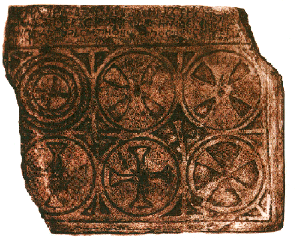Ban Kulin
- This article is about the Medieval Bosnian ruler. For other uses of the term, see Kulin (disambiguation).
Template:History of Bosnia Ban Kulin (1163 – 1204) was a powerful Bosnian Ban who ruled from 1180 to 1204 first as a vassal of the Byzantine Empire and then of the Kingdom of Hungary. He was brought to the power by Byzantine Emperor Manuel I Comnenus. He had a son, Stevan; who succeeded him as Bosnian Ban. Kulin founded the House of Kulinić.
Life
Kulin came to prominence in Bosnia 1163 as he was under the Byzantine Emperor Manuel I Comnenus who was just taking the country from the Hungarians earlier, although it would not be until 1180 that he would place Kulin as his vassal as Ban.
His rule is often remembered as Bosnia's golden age, and he is a common hero of Bosnian national folk tales. Bosnia was mostly at peace during his rule. However, in 1183, he lead his troops with the forces of the Kingdom of Hungary under King Bela that has just launched an attack on the Byzantine Empire together with the Serbs led by Kulin's relative, Duke of All Serbia Stefan Nemanja. The cause of the war was the new imposer to the Imperial throne Andronicus Comnenus that was not recognized as legitimate by the Hungarian crown. The united forces met little resistance in the eastern Serbian lands - the Greek squadrons were fighting among themselves as the local Byzantine commanders: Alexios Brannes supported the new Emperor, while Andronicus Lapardes opposed him - and deserted the Imperial Army, going onto adventures on his own. Without difficulties, the Greeks were pushed out of the Valley of Morava and the allied forces breached all the way to Sophia, raiding Belgrade, Braničevo, Ravno, Niš and Sophia itself. With the Hungarian withdrawal from the conflict, so did Ban Kulin stand down. In Kulin's times, the term Bosnia encompassed roughly the lands of Vrhbosna, Usora, Soli, the Lower Edges and Rama, which is approximately geographical Bosnia.
The Bogomils were expelled from Serbia by the Nemanyiden, so they settled and populated Bosnia, founding a unique Bosnian Church that greatly spread under Kulin's reign. The Dalmatian King of Zeta or Doclea Vukan Nemanjić reported the Ban to the Pope on 8 January 1199 for heresy because of that, claiming that evil stages are in store for the land of the Hungarian King. It appears that Kulin Ban and his wife, as well as his sister - the widow of Prince Miroslav - abandoned Christianity in favor of Bogumilism together with 10,000 of their Christian subjects. Kulin also gave protection to the banished heretics from Split and Trogir - which Vukan reported to the Pope. The Pope wrote to King Emeric of Hungary to make Kulin prosecute the Bogumils or depose him. Kulin subsequently, on 8 April 1203, organized a congress in Bilino Polje which the Pope's emissaries attended - led by the Pope's legate for the Balkan peninsular, John de Kazemaris; where he officially declared his allegiance to the Roman Catholic Church and declared that he was none other than a true pious Roman Catholic Christian. He claimed that he didn't understand where Heresy lied in Bosnia. This act seemed only political - as he only tried to save Bosnia from war and continued to practise heresy. The Pope's emissaries travelled to Hungary with Kulin's son, confirming Kulin's loyalty to the Hungarian crown and the Catholic Church. Prince Vukan was enraged and complained to the Pope that he was, in fact, lying; and demanded that the Pope command the Hungarian King to exterminate the Bosnian heretics. Between 1202 and 1204 Kulin assisted the deposed legitimate Serbian ruler Stefan Nemanjić in his struggles against Vukan.
At the end of his rule, in 1204, a certain Cotroman the German arrived to Bosnia, descendant of Cotroman the Goth from Ban Borić's time. He settled permanently in Bosnia and is to become the founder of the House of Kotromanić. Ban Kulin died in 1204 - he was succeeded by his son, Stevan.
The Charter
The Charter of Kulin is a symbolic birth certificate of Bosnian statehood, as it is the first written document that talks of Bosnian borders (between the rivers of Drina, Sava and Una) and of the elements of the Bosnian state: its ruler, throne and political organization. It also noted Bosnia's population - "Bosnianins". The Charter was a trade agreement between Bosnia and Republic of Dubrovnik and was written in the Bosancica Old Bosnian language.
Marriage and Children
Kulin's sister married the brother of Grand Prince Stefan Nemanja, the Serbian Prince Miroslav of Zachlumia in Rascia and Kulin himself had two sons:
- Stevan, the following Ban of Bosnia
- a son that went with the Pope's emissaries in 1203 to explain heresy accusations against Kulin
| Preceded by: under Byzantine Emperor Manuel I Comnenus's |
Bosnian Ban 1180–1204 |
Succeeded by: Stjepan |
See also
- History of Bosnia and Herzegovina
- Byzantine Empire
- History of Hungary
- List of rulers of Bosnia
- List of Bosnians
External links
- Bosnian history continued— The good Ban Culin
- The growth of the Bogomil churches under Culin — Their missionary zeal and success
Credits
New World Encyclopedia writers and editors rewrote and completed the Wikipedia article in accordance with New World Encyclopedia standards. This article abides by terms of the Creative Commons CC-by-sa 3.0 License (CC-by-sa), which may be used and disseminated with proper attribution. Credit is due under the terms of this license that can reference both the New World Encyclopedia contributors and the selfless volunteer contributors of the Wikimedia Foundation. To cite this article click here for a list of acceptable citing formats.The history of earlier contributions by wikipedians is accessible to researchers here:
The history of this article since it was imported to New World Encyclopedia:
Note: Some restrictions may apply to use of individual images which are separately licensed.
